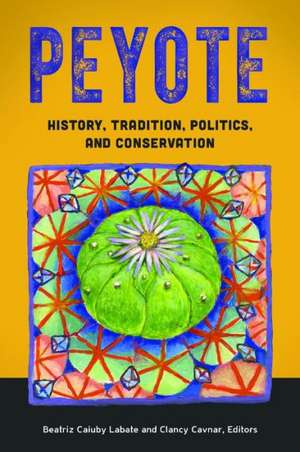Peyote: History, Tradition, Politics, and Conservation
Editat de Beatriz Caiuby Labate Cuvânt înainte de James A. Bauml Editat de Clancy Cavnar Cuvânt înainte de Stacy B. Schaeferen Limba Engleză Hardback – 17 ian 2016 – vârsta până la 17 ani
Preț: 368.61 lei
Preț vechi: 482.07 lei
-24% Nou
Puncte Express: 553
Preț estimativ în valută:
70.54€ • 75.42$ • 58.81£
70.54€ • 75.42$ • 58.81£
Carte tipărită la comandă
Livrare economică 18 aprilie-02 mai
Preluare comenzi: 021 569.72.76
Specificații
ISBN-13: 9781440834004
ISBN-10: 1440834008
Pagini: 312
Ilustrații: 27 bw illus
Dimensiuni: 156 x 235 x 25 mm
Greutate: 0.7 kg
Editura: Bloomsbury Publishing
Colecția Praeger
Locul publicării:New York, United States
ISBN-10: 1440834008
Pagini: 312
Ilustrații: 27 bw illus
Dimensiuni: 156 x 235 x 25 mm
Greutate: 0.7 kg
Editura: Bloomsbury Publishing
Colecția Praeger
Locul publicării:New York, United States
Caracteristici
Explains the complete history of the peyote plant in the United States, presenting views from religions including Native American and Christian churches, the creation and evolution of U.S. law regarding peyote, state and federal legal protections since 1990, reasons for the plant's apparent demise, and arguments for its stronger protection
Notă biografică
Beatriz Caiuby Labate, PhD, is professor at the Center for Research and Post Graduate Studies in Social Anthropology (CIESAS), in Guadalajara, Mexico, and visiting professor at the Drug Policy Program of the Center for Economic Research and Education (CIDE), in Aguascalientes, Mexico.Clancy Cavnar, PsyD, is a research associate of the Nucleus for Interdisciplinary Studies of Psychoactives (NEIP) and a clinical psychologist who works at a dual diagnosis residential drug treatment center in San Francisco, CA.
Recenzii
[An] excellent, up-to-date resource . . . . Summing Up: Recommended. Upper-division undergraduates through professionals/practitioners.
With its 12 chapters bringing together contributions from different areas, such as biology, ecology, history, law, anthropology, and the religious sciences, together with indigenous perspectives on the topic, this collection presents visions and approaches to peyote and at the same time explores some common and cross-cutting issues and questions. . . . Peyote today finds itself situated at a crossroads, one at which are encountered debates over environment and sustainability; national and international politics dealing with the use and trafficking of drugs; human and indigenous rights; and questions of an ethnic and religious nature. In this sense, one of the discussions raised in many different ways throughout this book is over how these diverse interests interact with one another and how they might be suitably balanced.
This collection truly is a great reference for those interested in peyote, its rich history, and how it is used today. . . . Despite the recent renaissance of psychedelic research, little mention has been made of the potentials of peyote and mescaline use. . . . This hole in research is precisely why this text is of importance to the field. It offers a comprehensive understanding of the politics and history of peyote, and with the information it provides, it is a perfect place to start for psychologists who have an interest in psychedelic research or the exploration of consciousness as it pertains to spiritual ceremonies, traditions, and religion. . . . Anyone who wishes to find out more about peyote and its rich history of spiritual and indigenous use, as well as its legality, will find this collection both informative and comprehensive. The book's truly interdisciplinary approach provides rich accounts that are so often difficult to find, or are left out entirely from research-based collections.
With its 12 chapters bringing together contributions from different areas, such as biology, ecology, history, law, anthropology, and the religious sciences, together with indigenous perspectives on the topic, this collection presents visions and approaches to peyote and at the same time explores some common and cross-cutting issues and questions. . . . Peyote today finds itself situated at a crossroads, one at which are encountered debates over environment and sustainability; national and international politics dealing with the use and trafficking of drugs; human and indigenous rights; and questions of an ethnic and religious nature. In this sense, one of the discussions raised in many different ways throughout this book is over how these diverse interests interact with one another and how they might be suitably balanced.
This collection truly is a great reference for those interested in peyote, its rich history, and how it is used today. . . . Despite the recent renaissance of psychedelic research, little mention has been made of the potentials of peyote and mescaline use. . . . This hole in research is precisely why this text is of importance to the field. It offers a comprehensive understanding of the politics and history of peyote, and with the information it provides, it is a perfect place to start for psychologists who have an interest in psychedelic research or the exploration of consciousness as it pertains to spiritual ceremonies, traditions, and religion. . . . Anyone who wishes to find out more about peyote and its rich history of spiritual and indigenous use, as well as its legality, will find this collection both informative and comprehensive. The book's truly interdisciplinary approach provides rich accounts that are so often difficult to find, or are left out entirely from research-based collections.






